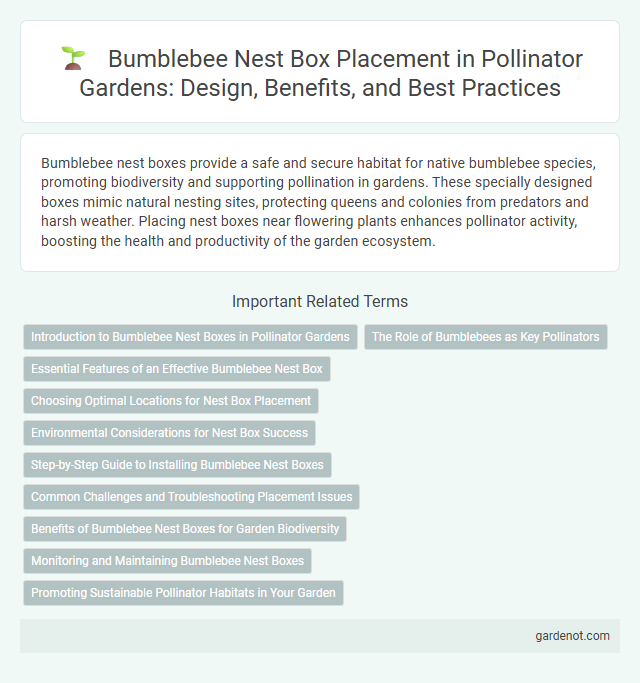Bumblebee nest boxes provide a safe and secure habitat for native bumblebee species, promoting biodiversity and supporting pollination in gardens. These specially designed boxes mimic natural nesting sites, protecting queens and colonies from predators and harsh weather. Placing nest boxes near flowering plants enhances pollinator activity, boosting the health and productivity of the garden ecosystem.
Introduction to Bumblebee Nest Boxes in Pollinator Gardens
Bumblebee nest boxes provide essential shelter and breeding sites for native bumblebee populations, enhancing pollination in pollinator gardens. These boxes are designed to mimic natural nesting habitats, such as abandoned rodent burrows, promoting colony establishment and growth. Installing bumblebee nest boxes supports biodiversity and helps sustain local ecosystems by increasing pollinator activity and crop yields.
The Role of Bumblebees as Key Pollinators
Bumblebees are essential pollinators, contributing significantly to the fertilization of wildflowers and agricultural crops such as tomatoes, berries, and clover. Their ability to perform buzz pollination allows them to release pollen more efficiently from certain plants, increasing fruit and seed production. Installing bumblebee nest boxes supports local populations by providing safe nesting habitats, boosting pollination services and enhancing biodiversity in pollinator gardens.
Essential Features of an Effective Bumblebee Nest Box
An effective bumblebee nest box should have a well-insulated interior to maintain stable temperatures, mimicking the natural underground nests preferred by bumblebees. Proper ventilation is crucial to prevent moisture buildup, which can harm developing larvae, while an entrance hole sized around 2-3 cm allows easy access for bumblebee queens. Durable, weather-resistant materials like untreated wood ensure longevity and protect the colony from predators and environmental stressors, supporting healthy pollinator populations.
Choosing Optimal Locations for Nest Box Placement
Selecting an optimal location for a bumblebee nest box involves identifying sheltered, shaded areas with minimal wind exposure and proximity to abundant flowering plants for foraging. Placement near ground-level vegetation or under dense shrubbery enhances humidity control and protection from predators, crucial for colony health and development. Ensuring the site is free from pesticide use and human disturbance further supports successful nesting and bumblebee population growth.
Environmental Considerations for Nest Box Success
Bumblebee nest boxes should be placed in sheltered, dry locations away from direct sunlight and strong winds to mimic their natural nesting habitats. Using breathable materials like untreated wood or natural fibers enhances ventilation and prevents moisture buildup, reducing the risk of mold and parasite infestations. Positioning nest boxes near diverse flowering plants ensures a consistent food source, promoting colony health and successful pollination.
Step-by-Step Guide to Installing Bumblebee Nest Boxes
Install bumblebee nest boxes by selecting a shaded, sheltered location close to flowering plants to ensure easy access to nectar and pollen. Secure the nest box at ground level or slightly above in dense grass or leaf litter, providing insulation and protection from predators. Regularly monitor and clean the box after the flowering season to maintain a healthy environment for future bumblebee colonies.
Common Challenges and Troubleshooting Placement Issues
Bumblebee nest boxes often face challenges such as moisture buildup, improper ventilation, and predators disrupting colony development. Incorrect placement, like exposure to direct sunlight or strong winds, can hinder bumblebee occupancy and nesting success. Ensuring the box is located in a shaded, sheltered spot with dry, well-drained soil helps optimize conditions for bumblebee habitation and colony growth.
Benefits of Bumblebee Nest Boxes for Garden Biodiversity
Bumblebee nest boxes enhance garden biodiversity by providing safe, insulated habitats essential for bumblebee colony establishment and survival. These boxes support pollination of diverse plant species, boosting ecosystem health and crop yields. Increasing bumblebee populations through nest boxes helps maintain balanced insect communities and promotes resilience in garden ecosystems.
Monitoring and Maintaining Bumblebee Nest Boxes
Regular monitoring of bumblebee nest boxes involves checking for occupancy, signs of wear, and potential predators to ensure a healthy colony. Maintaining optimal conditions includes cleaning the boxes annually, replacing bedding material, and positioning them away from direct sunlight and heavy rain. Effective upkeep of bumblebee nest boxes promotes pollinator health and supports local biodiversity.
Promoting Sustainable Pollinator Habitats in Your Garden
Bumblebee nest boxes provide safe, insulated habitats critical for sustaining local bumblebee populations, enhancing pollination in your garden. Strategically placing these boxes in shaded, undisturbed areas supports colony establishment and boosts biodiversity. Incorporating native flowering plants nearby ensures continuous food sources, promoting a resilient and thriving pollinator ecosystem.
Bumblebee nest box Infographic

 gardenot.com
gardenot.com